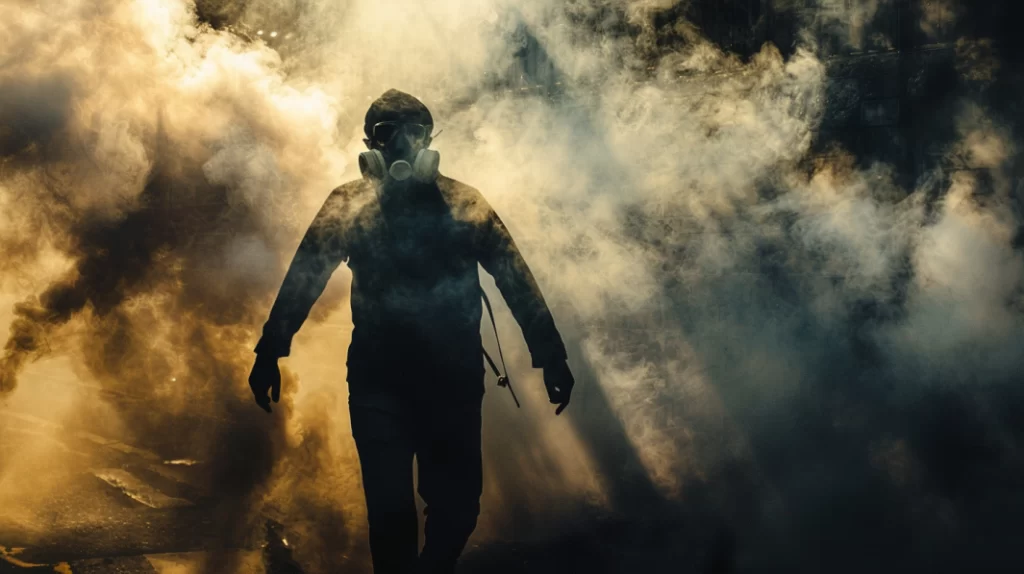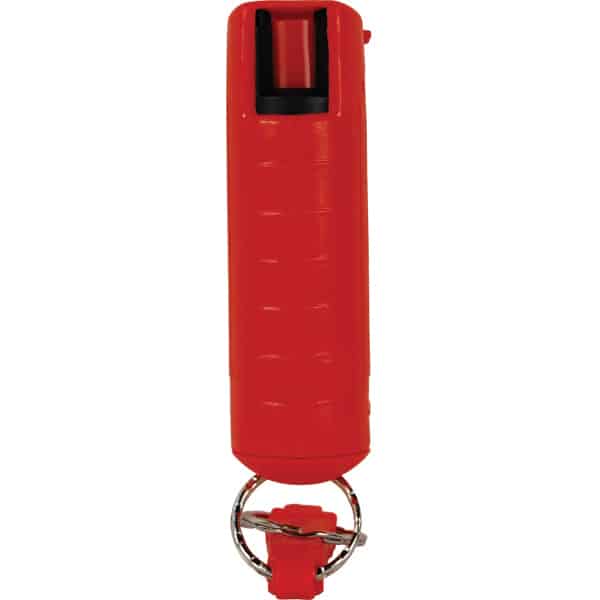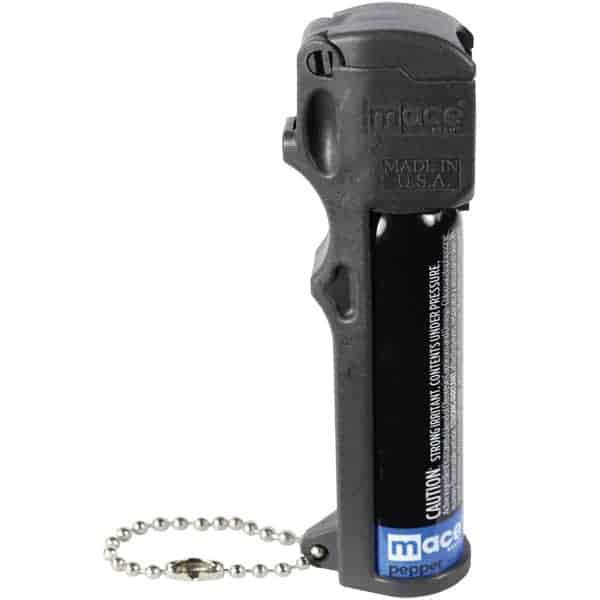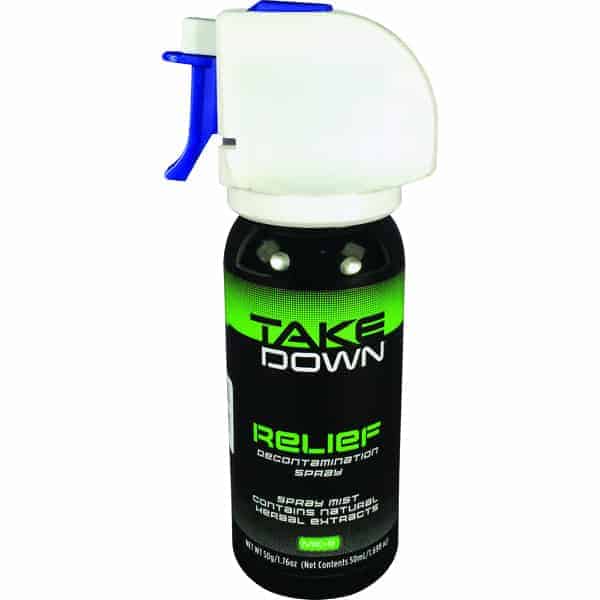
You might wonder how tear gas differs from pepper spray. Pepper spray, used mostly for self-defense, contains oleoresin capsicum from hot peppers that cause intense burning and temporary blindness.
On the other hand, tear gas, often deployed by law enforcement in crowd control scenarios, includes chemicals like CS or CN that irritate the eyes and respiratory system, leading to severe discomfort and tears.
While pepper spray is legal for civilian use in many places, most tear gas is usually limited to law enforcement. Each has specific delivery methods, effects, and legal considerations. Exploring these differences further might surprise you with useful insights.
Pepper spray’s active ingredient, oleoresin capsicum, comes from capsaicin in hot peppers, while tear gas contains chemicals like CS or CN, affecting the body in different ways. Understanding these differences helps you see why each causes unique reactions when used.

When you encounter pepper spray, oleoresin capsicum (OC) acts as the main irritant. This natural oil doesn’t just cause pain; it creates a strong burning sensation on the skin and can make breathing hard if you breathe it in. Its effects are immediate, overwhelming your senses, forcing your eyes shut from irritation, and making your skin feel like it’s on fire.
On the other hand, tear gas, using 0-chlorobenzylidenemalononitrile (CS) as the active compound, mainly targets your eyes. It makes them tear uncontrollably, causing severe eye irritation and temporary blindness. The chemical composition of CS is synthetic, made to disorient rather than cause intense physical pain like OC.
Both tear gas and pepper spray are potent deterrents, but their chemical makeup determines whether you’ll mostly feel burning or intense tearing. This distinction in their active compounds fundamentally changes how they affect you during exposure.
When it comes to tear gas, most people think about how it’s used by law enforcement to control riots. However, tear gas isn’t just for those situations. In fact, some types of pepper spray contain tear gas as one of their main ingredients.
One example is the Mace Triple Action model. These products mix OC pepper spray, tear gas, and UV dye. They’re designed for individuals looking to protect themselves. Adding tear gas to these models provides an extra layer of defense by causing irritation and temporarily incapacitating potential attackers.

The availability of pepper spray products with tear gas highlights that these non-lethal weapons have various uses beyond law enforcement. People, especially those concerned about safety, can use these tools to feel more secure in different situations.
However, it’s important to remember that tear gas should be used carefully, even in self-defense situations. Following the law is crucial to avoid causing unintended harm or facing legal issues.
When law enforcement uses tear gas, they typically deploy it using grenades that spread the chemical over a wide area, making it ideal for controlling crowds. This method allows officers to effectively manage large groups from a distance, ensuring the gas covers the space and affects a wide radius. Grenades can be thrown or launched depending on the situation, providing flexibility in how the gas is distributed.
On the other hand, pepper spray is more personal. It is usually contained in aerosol cans offering different application styles—stream, mist, gel, or foam. Each form is suitable for different scenarios, from the gel that sticks to the attacker, reducing blowback, to the mist that can incapacitate multiple threats at close range. This makes pepper spray a preferred choice for civilians seeking an accessible and effective self-defense option.
Tear gas and pepper spray use these specific delivery methods to cater to their distinct roles—for broad, indiscriminate coverage in crowd control and for precise, targeted action in personal defense. Understanding these methods helps you grasp how each tool is designed for its particular use.
When exposed to pepper spray, you’ll immediately feel an intense burning sensation, primarily affecting your eyes. This intense reaction leads to uncontrollable eye-watering and can cause temporary blindness, making it difficult to see anything.
Tear gas impacts you by causing a severe burning sensation in your nose, eyes, and throat. This isn’t just uncomfortable; it’s overwhelmingly painful and can lead to prolonged coughing fits. Like pepper spray, tear gas also prompts a small rise in blood pressure, compounding your body’s physical stress.
Both agents have acute effects designed to temporarily incapacitate, making it challenging for you to maintain your bearings or manage an effective response to the situation. These tools are potent, and their physical impacts are profound, emphasizing their role in controlling or dispersing crowds by inducing temporary but intense discomfort.
People use pepper spray for personal defense in different situations, while police typically deploy tear gas to manage large crowds or SWAT situations. Pepper spray is your best choice when you’re facing an immediate threat up close. It’s crucial for disabling an attacker, giving you valuable seconds to escape. Since it targets specific individuals, you won’t risk affecting bystanders unnecessarily, making it perfect for self-defense.

On the other hand, tear gas is used more for chaotic situations. Law enforcement uses it to maintain order when crowds become uncontrollable. By dispersing tear gas, police can cover a wide area, influencing the behavior of a large group without resorting to lethal force. This method helps prevent escalations and quickly restore peace.
Both options are non-lethal irritants, important in situations where lethal force is not justified or desired. Whether it’s the personal safety that pepper spray offers or the crowd control capabilities of tear gas, these tools provide effective means for safety and order while minimizing potential harm.
Understanding how and when each tool is appropriately used is crucial as you navigate personal safety and public security.
Before you decide to carry pepper spray or tear gas, make sure to check the specific laws in your area. Laws can vary a lot depending on where you are and can impact your decision.
In many places, civilians are allowed to use pepper spray for self-defense. However, tear gas is a bit trickier, as it might be restricted to use only by law enforcement or the military and can be completely illegal for civilians to own.
It’s crucial to know that while pepper spray can help keep you safe, the rules about owning and using it are not the same everywhere. Some areas might require a permit or a certain age, while others might ban it altogether. Tear gas is more tightly regulated because of its strong effects and its usual link to controlling riots.
That’s why it’s essential to understand the local rules before getting or carrying these substances. Not knowing the law doesn’t protect you, and you definitely don’t want to get into legal trouble because you thought you were just protecting yourself. Always ensure you follow the laws in your area to avoid any problems.
If you’ve been exposed to tear gas or pepper spray, it’s crucial to act quickly to decontaminate effectively. First, get to fresh air as soon as possible. This step helps reduce the gas’s impact on your respiratory system and eyes.

Your immediate focus should be on rinsing the affected areas. If you’ve been exposed to tear gas, flush your eyes with water. Remember, avoid rubbing them, as this can make the irritation worse.
Similarly, if pepper spray has come into contact with your skin or eyes, rinse these areas with cool water to help ease the burning sensation. Avoid hot water, as it can intensify the reaction.
Also, make sure to remove any clothing that may have been contaminated by these substances. This helps prevent prolonged exposure and ongoing discomfort. Remember, following these safety precautions is crucial in reducing the effects of tear gas and pepper spray exposure.
| Action | Tear Gas Exposure | Pepper Spray Exposure |
|---|---|---|
| 1. Fresh Air | Immediately seek | Immediately seek |
| 2. Remove Clothing | Remove to avoid residue | Remove to avoid residue |
| 3. Rinse | Eyes and skin with water | Affected areas with cool water |
In addition to these tips, you can use a decontamination spray like the Take Down OC Relief, which, thanks to its natural herbal extracts, can help decontaminate affected areas.
Tear gas uses chemical irritants, while pepper spray harnesses capsaicin from peppers. Each causes intense, albeit different, physical reactions.
Both tear gas and pepper spray cause irritation. Tear gas causes coughing and nausea, while pepper spray leads to severe eye pain and temporary blindness. Both increase blood pressure.
Both cause intense pain and discomfort, but pepper spray’s effects on the eyes and skin can feel more immediate and severe.
Pepper Spray Wholesale provides non-lethal self defense products and hidden cameras for you, your loved ones and your home. If you have any questions about the products, do not hesitate to Contact Us. Stay Safe!
Pepper Spray Wholesale
1867 Caravan Trail
Ste 105
Jacksonville, FL 32216
Call us toll free: (800) 859-5566